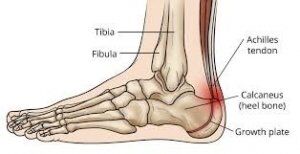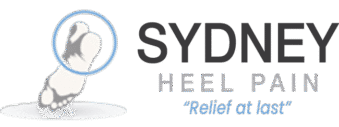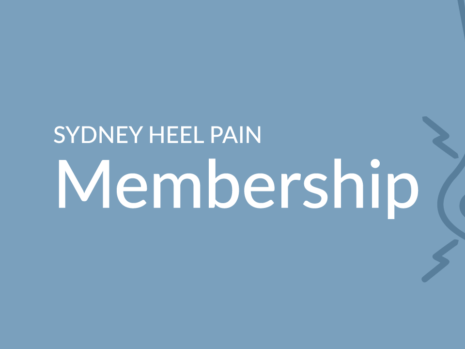Upper Heel Pain
What is a Possible Cause of Upper Heel Pain?
One of the most common causes of upper heel pain is insertional Achilles tendinopathy. This condition is sometimes confused with Achilles tendinitis which affects the tendon more proximally above the heel bone. As opposed to feeling upper heel pain, patients with Achilles Tendonitis will normally describe lower calf pain or discomfort around the back of the ankle joint. Insertional Achilles tendinopathy is associated with a degeneration or a breakdown of the Achilles tendon at the insertion onto the back of the heel bone. Many patients suffering with insertional Achilles tendinopathy will describe the feeling of stiffness or extreme pain for the first few steps in the morning. These patients also report that the upper heel pain is prominent when lying in bed. The posterior aspect of the heel bone can feel uncomfortable as it rests and gently presses onto the bed sheets and mattress. Commonly, these patients describe an improvement in symptoms after they have began walking. The upper heel pain is normally noticeable first thing in the morning when the patient places their foot onto the ground and begins to walk.
This discomfort begins to ease within the first 5 to 10 minutes as circulation increases and mobility improves. Upper heel pain caused by insertional Achilles tendinopathy can sometimes be seen in association with Haglunds deformity which appears as a large bony prominence on the posterior aspect of the heel bone. Haglunds deformity can be clearly seen on x-ray imaging and appears as a spiky piece of bone that grows in an upwards direction towards the Achilles tendon. The upper heel pain from this condition can be exacerbated from the pressure of shoes on the back of the heel bone. The degeneration associated with this Achilles tendon problem can be age related but can also be seen in conjunction with stiffness and tight calf muscles. Most patients presenting to the Sydney heel pain clinic complaining of upper heel pain are aged in their 50s and 60s. These patients are often slightly overweight and have developed tight calf muscles. Interestingly, most of these patients report an improvement in the upper heel pain when they wear shoes with an elevated heel and a slight drop towards the front of the foot.
Elevating the heel reduces the pulling sensation of the Achilles tendon on the heel bone which reduces the upper heel pain quite significantly. However, long-term use of shoes with an elevated heel does in fact contribute to an overall shortening of the calf muscle and Achilles tendon. This would prolong the condition and results in extended periods of upper heel pain when wearing lower shoes.

Other Causes of Upper Heel Pain
Another cause of upper heel pain which often goes undiagnosed is a retro calcaneal bursitis. This condition can quite clearly be diagnosed using ultrasound imaging or MRI. Anatomically, this bursar exists naturally in order to lubricate the posterior aspect of the ankle joint around the Achilles tendon. However, if there is an increase in the amount of pulling around the posterior aspect of the heel bone, the bursar becomes irritated and inflamed. This irritation leads to upper heel pain and significant stiffness through the ankle joint itself. Once again, the upper heel pain symptoms are prominent first thing in the morning but will ease as the patient becomes more and more mobile.
This upper heel pain can be mildly uncomfortable during the first few minutes of exercise but most patients will report to the sports podiatrist that once they are warmed up they are able to successfully complete their activity as the pain dissipates. To this end, participants become reluctant to avoid or reduce physical exercise. However, the irritation to the affected Achilles tendon or bursar persists throughout the activity and causes further irritation. Even though the upper heel pain can be minimal or non-existent during this activity, the stress and load on the soft tissue prolongs the condition.
The sports podiatrists at the Sydney heel pain clinic commonly differentiate between these two different types of upper heel pain and implement the most relevant treatments accordingly. The treatment for each of these two conditions will differ slightly and can sometimes involve ultrasound imaging.
If you are experiencing upper heel pain you may wish to consult with the podiatrists at the Sydney heel pain clinic. Appointments can be made by emailing he**@****************om.au or by calling the following phone number: 9388 3322.
Written by Karl Lockett





